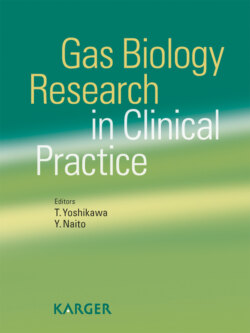Читать книгу Gas Biology Research in Clinical Practice - Группа авторов - Страница 17
На сайте Литреса книга снята с продажи.
Abstract
ОглавлениеGases are also produced while passing through the gastrointestinal tract, possibly resulting in abdominal symptoms although gas is continuously removed by eructation, anal evacuation, absorption through the intestinal mucosa, and bacterial consumption. It seems that 2–8 liters of air may be swallowed and eructated per day. Approximately 5–10 liters of CO2 seems to be produced and released into the lumen by chemical reactions in the upper gut. The pCO2 rises dramatically in the duodenum, resulting in diffusion of CO2 from lumen to blood, whereas CO2 in swallowed air diffuses from the blood into the stomach. The pN2 of swallowed air is slightly higher than that of venous blood in the stomach, possibly resulting in very slow absorption. Since pH2 and pCH4 are always higher in the lumen than in the blood, gases are constantly diffusing from the lumen to the blood. The calculated amount of H2 produced in the colon is 2.7–27 liters per day because H2 gas is produced at a rate of 4 liters for every 12.5 g of undigested carbohydrate. Since CH4 production occurs primarily in the left colon whereas H2 is produced primarily in the right colon, H2 produced in the left colon may be rapidly converted to CH4, possibly resulting in reduced flatus. Greater amount of gases pass through the digestive tract per day than liquid and solid contents, suggesting that impaired gas movement might be more closely associated with abdominal symptoms compared to liquid movement.
Copyright © 2011 S. Karger AG, Basel
The overall function of the digestive system is to transfer the nutrients in food from the external environment to the internal environment. During the course of the day, an adult usually consumes about 800 g of food and 1.5 liters of water and most of the nutrients and water are normally absorbed in the small intestine. Only approximately 150 g are eliminated from the body as feces. Secretion into the tract may amount to 7-8 liters of fluid, resulting in a total of 9-10 liters of fluid passing through the tract per day. Thus, a great amount of gases enter or leave the gastrointestinal tract with both solid and liquid substances.
On the other hand, although the intestines of normal subjects usually contain less than 200 ml of gas regardless of taking meals, the gastric bubble present in approximately 70% of normal chest and abdominal radiograph results from the 2-3 ml of air conveyed to the stomach with each swallow [1]. Gas within the stomach may exit via the esophagus by way of belching or via the duodenum, but most of the swallowed air should be regurgitated as a belch. The rate of excretion of gas per rectum is highly variable, ranging from 476 to 1,491 ml/day [2]. Gases are also produced while passing through the gastrointestinal tract, possibly resulting in abdominal symptoms although gas is continuously removed by eructation, anal evacuation, absorption through the intestinal mucosa, and bacterial consumption.
